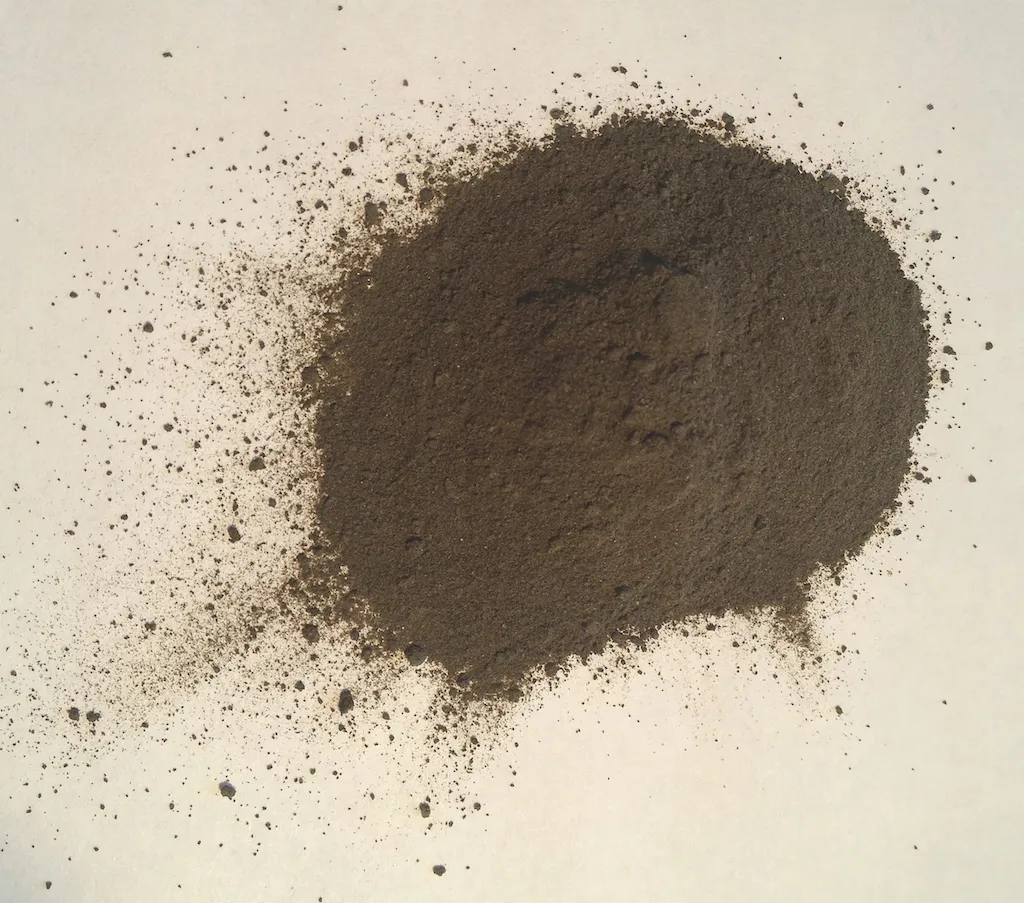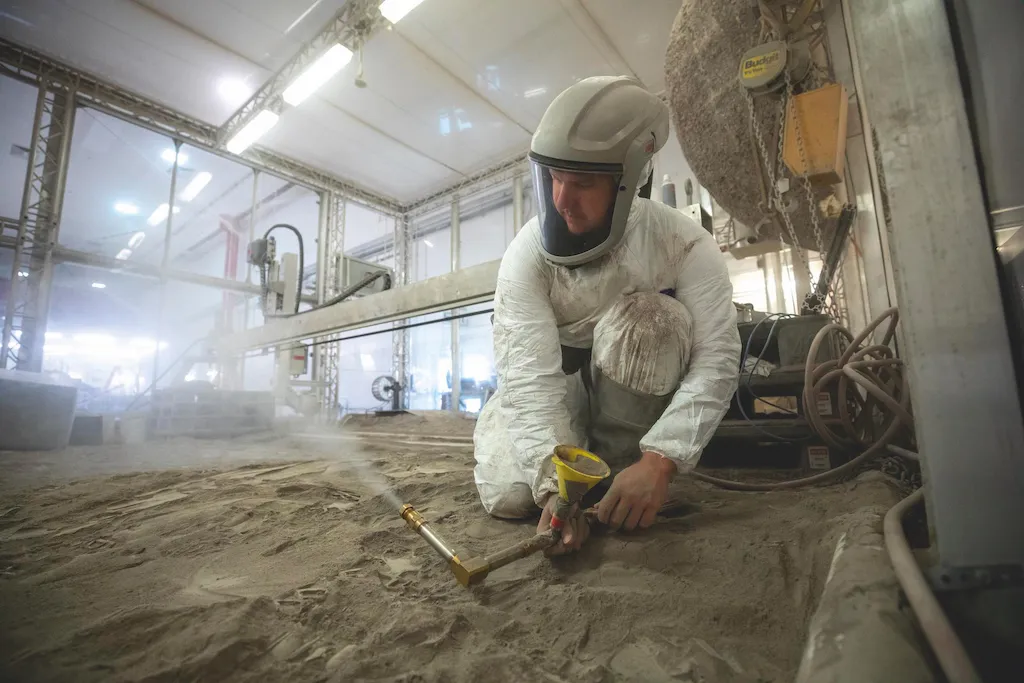Nighttime in the Mojave Desert. The stars of the Milky Way turn slowly above a landscape so dark you can barely make it out. Suddenly, spotlights switch on. They’re angled low to the horizon and off to one side, but spill light across a pale grey, undulating terrain that’s pockmarked by craters. You know you’re standing among the sands of California, but lit like this, it looks like you’re on the Moon.
This ‘Moon in the Mojave’ is the work of spaceflight company Astrobotic, which has been building the Lunar Surface Proving Ground (LSPG).
What secrets lie at the lunar south pole?
The 100m2 (approx 1,000ft2) site has been made to look exactly like the lunar south pole. The region was ignored by early Moon explorers, but has witnessed a surge in interest over the last decade after signs of water ice were found in the permanently shadowed recesses of deep craters. Such water could be an invaluable resource both for science and future explorers.
They’re just two of a great many missions supporting NASA’s Artemis programme to return humans, including the first woman and person of colour, to the lunar surface by the end of the decade.
But before either Peregrine or Griffin can even think of leaving the ground, they have to be fully tested.
“We do everything we can to simulate the lunar and space environment on Earth before we send our spacecraft off, because you can’t practise in space,” says Alivia Chapla, director of marketing at Astrobotic.
“Once you send the spacecraft out, it’s out there. For robotic missions, you can’t fix or touch it once it leaves this planet.”
As such, tests are vital for working out any potential problems while they can still be fixed. But when your vehicle is bound for a landscape unlike any on Earth, performing these tests isn’t easy.
The next generation of spacecraft
The Soviet Lunokhod robotic rover and the Apollo human-driven rover were both designed and built in the 1960s before anyone really knew what the lunar surface was like. Both were tested on Earth, but when the Soviet drivers of Lunokhod-1 first took to the rover’s remote controls, it was obvious these rehearsals were woefully inadequate.

With no atmosphere or colour on the Moon to provide a sense of depth, it’s difficult to interpret the topography of the landscape at the best of times, but the Lunokhod-1’s black and white cameras also removed any subtlety that might have made it easier.
Unlike the Soviets of the 60s, Astrobotic has been able to accurately scan the area it plans to land on, allowing the company to recreate the topography at the LSPG.
“The LSPG mimics the look and feel of the Moon,” says Chapla. “We’re making it from a light grey, highly reflective, thin layer of stucco [or render, a construction material made of aggregate, a binding agent and water] to mimic the lunar surface.”
Astrobotic will be able to fly test builds of its guidance cameras and ranging equipment over the LSPG, or even train its drivers on how to navigate across it to make sure they’re fully prepared to tackle the lunar south pole.
What are the challenges?
Trivial as it might sound, one of the biggest challenges facing landers and rovers at the lunar south pole is light. The Sun comes in low to the horizon, somewhere between 5-10°, creating long shadows.
It means there are shaded corners in and around craters that have been dark for billions of years, which is how water has been able to survive on the lunar surface for so long. But these same shadows also make it very difficult to see the landscape clearly.
Because the LSPG is so large, it needs to be outside, meaning there’s only one way to simulate lunar lighting conditions. “We actually do a lot of our testing at night. We simulate extreme lighting with different spotlights. We’ll simulate the light coming from the Sun [and] we’ll simulate Earth’s glare, depending on what we’re looking at,” says Chapla.
How to recreate a billion-year-old landscape
The LSPG’s solid stucco surface emulates the roughness of the lunar surface visually, but what it fails to recreate is how it feels. The real Moon is covered in fine dust. This regolith, as it’s known, was formed over billions of years by meteorites, large and small, striking the surface and grinding up the rock there.
You wouldn’t have to travel far from Astrobotic’s LSPG to find a simulated lunar landscape with realistic dust, though. Located in nearby Silicon Valley is NASA’s Ames Research Center, home to the Lunar Lab and Regolith Testbeds. Here, you’ll find two windowless rooms with walls that are painted black so that
they’re utterly dark when the lights are off. In the middle of each room is a giant sandbox filled with 20 tonnes of fake Moon dirt.
The simulated regolith in the older of the two labs is the same dark grey as the lunar mare – the dark patches visible on the Moon’s face. The set-up in the newer lab, however, better resembles the bright landscape of the lunar south pole.
Getting the lighting right is important
Just like at Astrobotic, spotlights mimic the low Sun at the lunar pole, but here the light plays strangely on the surface. The dust grains act like tiny reflectors, shaping the light in strange ways that can confuse cameras and computers trying to interpret the terrain.

NASA engineers are able to craft craters, mounds or any other shape into the testbeds, allowing them to pit their navigation systems against the obstacles to see how they fare in the unusual lighting.
“It’s not unlike crafting a really fine piece of pastry,” says Dr Terry Fong, Ames’s chief roboticist. Currently, he’s part of the team developing and building the Volatiles Investigating Polar Exploration Rover (VIPER) that NASA hopes to send to the lunar south pole by 2024 to analyse the potential resources that might be found there.
“[We] shape the craters, we’ll put in small rocks, but then we’ll take a handful of simulants and sprinkle it across the top. As it hits, it creates all these little pockmarks all over the surface. It’s very labour intensive, but it’s somewhat artistic.”
Terrestrial analogues for lunar dust
Though the Apollo missions brought back an impressive 382kg (842lbs) of Moon rock, this isn’t nearly close to the 20 tonnes needed to fill a regolith bin. Instead, lunar analogue facilities use a specially made simulant regolith. When making it, the first step is to find rocks on Earth that are the closest match to those found on the Moon.

“Fifteen years ago, lunar simulant was typically something called JSC-1A,” says Greg Schmidt, director of the Solar System Exploration Research Virtual Institute (SSERVI) at Ames Research Center.
This simulant is made from glass-rich volcanic rock known as basalt, gathered from the Merriam Crater near Flagstaff, Arizona as its mineralogy closely matches the rocks brought back by Apollo 14.
“It’s dark grey in colour and a really good simulant for the mare – the dark areas on the Moon.”
Getting the composition just right
JSC-1A fills one test bed at Ames; the other is filled with LHS-1, a simulant made of anorthosite from the Stillwater Mine in Montana, which is a better match to the lunar highlands of the Moon’s south pole. “When we got the pure anorthosite, it was so bright that we realised we needed to mix in a little bit of basaltic glass to make it more like what we actually see,” says Schmidt.
For mechanical testing, where a perfect chemical match isn’t as important, there are other simulants made from more readily available rock, meaning they can be produced in bulk more cheaply. These base rocks are ground down and sifted into several grades, from fine to coarse.
What simulants don’t recreate, however, is the smell – moon dust is odourless. And yet, all of the Apollo moonwalkers reported that the real lunar dust smelt of “spent gunpowder”.
“It was like burnt charcoal,” said Buzz Aldrin. “Similar to the ashes that are in the fireplace, especially if you sprinkle a little water on them.”
How does moondust behave?
But visual systems aren’t the only aspect of a rover that needs to be tested. This is why there are many other such regolith bins, including one at Astrobotic, as well as at the Simulated Lunar OPErations Lab (SLOPE) at NASA’s Glenn Research Center in Ohio. These might not resemble the Moon as closely, but instead, they allow teams to test how the dust behaves.
“A big concern we have is, ‘can the rover get stuck?’" says Fong. “It’s a wheeled rover going to a place we’ve never been before. We’ve put VIPER into a variety of configurations – different angles, obstacles, loose and hard-packed soil.”
During several of these tests, the rover did indeed get stuck. This, counterintuitively, was actually a good thing, as it not only helped shape the rover’s design to reduce the chances of it getting stuck on the Moon, but also allowed the operators to develop new techniques that would help them work the rover free if it did.
“VIPER has active suspension and one of the things we can do is independently lift up each wheel,” says Fong. “We can [make VIPER] ‘swim’ – like a breaststroke – through the soil.”
The difficulties of working with moondust
The regolith bins are usually surrounded by clear plastic sheets, as a rover trying to dig itself out often flings a lot of dust around. It’s important to keep the dust contained, as lunar regolith has a long history of getting everywhere.

Recalling his time on the Moon, astronaut Buzz Aldrin said: “The more time you spend there, the more you get covered from helmet to boots with lunar dust.”
The Apollo astronauts encountered quite a few problems with dust. The fine powder was easily breathed in, causing lung irritation (and even an allergic reaction, in the case of Apollo 17’s Harrison Schmitt).
The dust also affected the non-human components of the mission. It was so abrasive it ate into spacesuits and gummed up the joints on equipment. The problem grew worse when the later missions arrived with the lunar rover, which kicked up huge ‘rooster tails’ of dust as it traversed the landscape.
“By the middle or end of the third EVA [extra vehicular activity], simple things like bag locks and the lock that held the pallet on the rover began to not only malfunction, but to not function at all,” said Apollo 17 astronaut Gene Cernan in his post-mission debrief. “You’re continually fighting the dust problem, both outside and inside the spacecraft.”
Why is moondust so hazardous?
The reason for lunar dust’s hazardous properties becomes immediately obvious when you see it under a microscope. “If you look at lunar dust – the real stuff – you see these very jagged, tiny pieces of lunar material,” says Greg Schmidt, the director of the Solar System Exploration Research Virtual Institute (SSERVI) at Ames.
Earth-made simulants aren’t quite as bad as genuine regolith, as natural weathering has blunted their edges, but they’re still fine enough to breathe in. “When you’re changing the surface, such as putting in a simulated crater, you want to wear protective gear. But once that’s settled, it’s actually okay to be in the same room,” says Schmidt.
Even with all these regolith bins, there are some aspects of lunar exploration that are far more difficult to emulate. It’s impossible to recreate the Moon’s gravity, which is one-sixth that of Earth's, though the engineers have found some clever tricks to fake it (see ‘Artificial Gravity’, right).
The problem of artificial gravity
The different gravity of the Moon is one of the most difficult things to simulate when it comes to testing lunar equipment.
“We care a lot about that because the gravity on the Moon is one-sixth that of Earth,” says Dr Terry Fong, director of the Intelligent Robotics Group (IRG) at Ames Research Center. “In terms of a wheeled rover like the Volatiles Investigating Polar Exploration Rover (VIPER), you worry how it will drive – if you hit a bump, will the whole vehicle jump?”
It’s impossible to change Earth’s gravity, so engineers have developed a variety of creative methods to emulate the Moon’s reduced gravity as best they can.
Simulating lunar gravity
One of the most famous methods is using parabolic flights, which see stripped-out passenger planes fly at sharp ascent and descent angles to produce the illusion of reduced gravity. It’s not ideal though, as each arc only offers 10-20 seconds of testing time and you can’t use a regolith bin unless you want the entire cabin to be filled with simulant dust.

If you want to simulate lunar gravity while also using a fake terrain, there are other techniques. One method, used to test the Apollo rovers in the 1960s, is to build a test vehicle that has the same driving systems that your flight model will have, but with everything else stripped out so it’s one-sixth the mass.
“Another thing you can try is gravity offset,” says Fong. “It’s where you use a crane or, if it’s a small rover, a large helium balloon (have you seen the movie Up?) to reduce the effective mass.”
One thing neither of these methods manages to do, however, is reduce the mass of the actual dust particles. The only way to tell how that might affect a rover will be to see what happens when it gets to the Moon.
Radiation on the Moon
Another big concern is radiation, but current radiation testing facilities are only large enough to test individual components, not entire rovers. Size is not a problem when it comes to testing how rovers fare in a vacuum, though – NASA has some of the largest vacuum chambers in the world.
Yet, while it might seem like a simple matter to set up a regolith bin inside of one, the truth is that the dust thrown around in the process would destroy the chambers’ delicate valves and seals.
“Ideally, we would like to have as many factors be as close as possible to the actual environmental conditions,” says Fong. “But the reality is that we have great difficulty trying to do that all at the same time.”
The long-term goal
Indeed, there won’t be any way to test every aspect of a lunar vehicle until it’s on the surface. NASA’s long-term plan is to set up a research base on the Moon, so perhaps one day future explorers will be able to test their designs on the real surface.
Until then, they’ll have to make do with the little pieces of makeshift Moon – like Astrobotic’s LSPG and NASA’s regolith bins – that can be found right here on Earth.
Read more:
